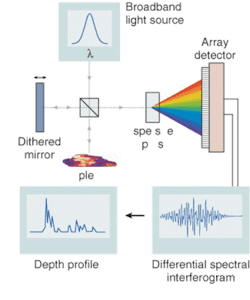Based on previous work in biomedical fluorescence microscopy and ultrafast-laser pulse characterization, researchers at Southwest Sciences (Santa Fe, NM) are attempting to combine optical computed tomography (OCT) with spectral interferometry (SI) for a high-performance version of OCT. They refer to the proposed method as differential spectral interferometry (DSI) or a differential version of frequency-domain OCT (FD-OCT).
Both OCT and SI are low-coherence optical imaging methods, but OCT operates in the time domain, while SI operates in the frequency domain. On the one hand, OCT is emerging as a noninvasive alternative to some medical biopsy procedures, because good dynamic range and image resolution enable it to provide subsurface imagery of cellular details at speeds approaching video frame rates and resolutions approaching one micron. On the other hand, SI offers potential improvements of inherently parallel spectral-data acquisition and a simpler mechanical system by removing the need for moving parts and for a high-speed optical delay line in the reference arm of the OCT interferometer.
"Time-domain OCT provides a high practical dynamic range, which is close to the theoretical limit," said senior scientist Andrei Vakhtin during a technical presentation at the OSA annual meeting in October. "With frequency-domain OCT or spectral interferometry, the detection is parallel, which results in a higher theoretical dynamic range." Practical difficulties, such as high-bandwidth signal detection, background signal from the light source, and interference among different surfaces within the sample, can prevent SI imagers from taking full advantage of parallel detection and approaching theoretical shot-noise limits for dynamic range.
These concerns can be addressed in part by replacing the usual scanning mirror in the OCT reference arm with a quarter-wavelength (p phase shift) dithering mirror, which introduces a controlled phase delay to the reference arm.1, 2 When the spectral interferograms obtained with and without the phase delay are subtracted, a differential spectral interferogram is obtained. A Fourier transform of the differential interferogram produces a background-free image, which allows boosting the signal-to-noise ratio by averaging multiple images. Also, the amplitude of the signal of interest doubles compared to simple SI.
Differential spectral interferometry (DSI) combines the parallel data acquisition of spectral interferometry with the good dynamic range and image resolution of optical computed tomography (OCT). The dithered mirror at left in the Michelson interferometer structure provides p phase-shifted signals that are subtracted to yield the differential spectral interferogram. The photodiode array with lock-in detection for each channel at right enables parallel, low-bandwidth detection. A Fourier-transform step cancels the DC background signal and boosts signal-to-noise ratio.
In addition, unlike the inherent DC (direct-current) mode of SI measurements, DSI can acquire data in an AC (alternating-current) mode, which is compatible with lock-in detection and low-bandwidth signal detection (see figure). So, by using a photodiode array with lock-in detection for each channel of a multichannel DSI imager, the Southwest Sciences team hopes to take full advantage of parallel detection, Vakhtin said. For a given imaging rate, the DSI version with multichannel lock-in detection should have an advantage of up to 30 dB in dynamic range over time-domain OCT.
REFERENCE
- M. Wojkowsi et al., J. Biomed. Opt. 7(3): 457.
- A.B. Vakhtin et al., Optics Lett. 28(15): 1332.
